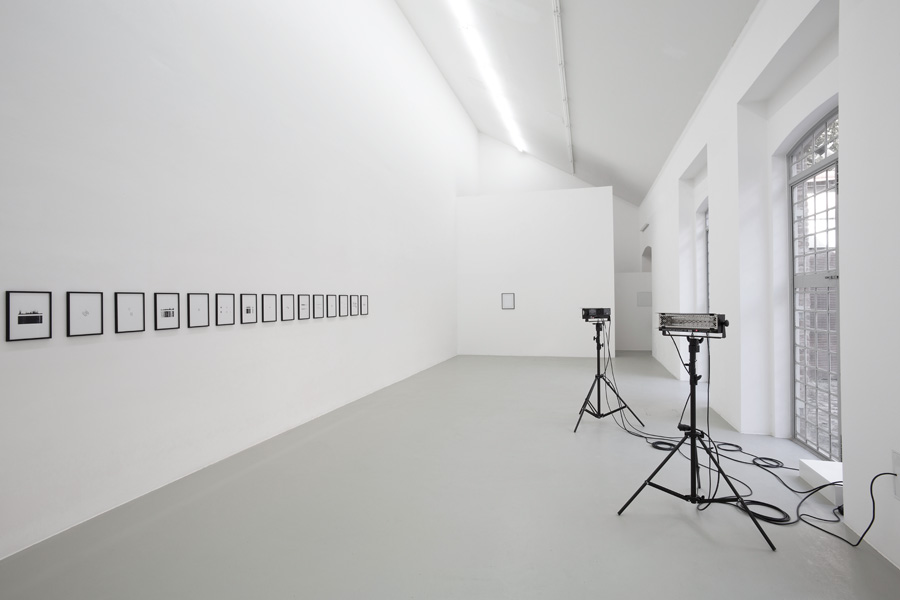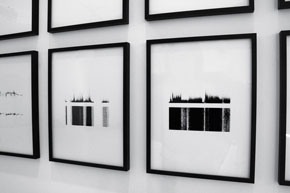
Andrés Ramírez Gaviria, "sources," 2009 – 2012.
30 gelatin silver prints, each 27.5 x 21 cm, framed, stroboscopic lamps, DMX controller, sound performance, Variable dimensions.
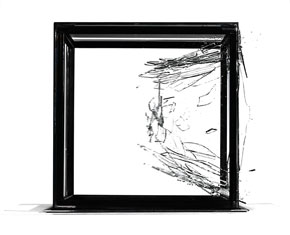
Andrés Ramírez Gaviria, ".0," 2010.
HD video, color, no sound, 5:30 mins.
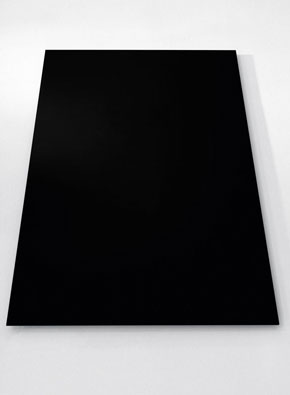
Andrés Ramírez Gaviria, "beyond black," 2010.
Nano-sized grid on glass,168 x 84 cm.
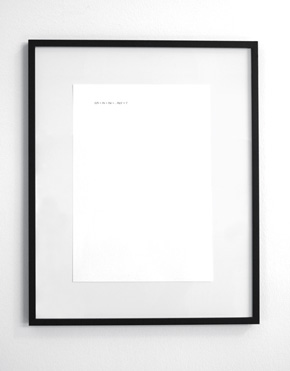
Andrés Ramírez Gaviria, "formula," 2010.
Inkjet print on paper 41.5 x 34.5 cm
|
|
On the exhibition
Andrés Ramírez Gaviria
A Volume, However Small, Will Have an Infinite Number of Planes
In the exhibition "A Volume, However Small, Will Have an Infinite Number of Planes," artist Andrés Ramírez Gaviria draws on the interpretative and performative aspects of science, addressing along the way artistic issues of autonomy and communication. On display are the works sources, a translation of radio signals from astronomical objects into 30 images and a live sound performance; formula, a mathematical formula for the creative process put forward in 1919 by the Russian critic Nikolai Punin; and 0., a four-minute video that documents the implosion of a glass cube.
In the work of Andrés Ramírez Gaviria, forms, figures, and discourses from art, design, and technology are repurposed through the processes of translation and transference. Through clever manipulations and playful contradictions, Gaviria addresses notions such as autonomy and communication. Often collaborating with technologists and scientists, his work manifests a perpetual state of tension that evokes both a curious attraction to and a questioning of his subjects.
"A Volume, However Small, Will Have an Infinite Number of Planes" is a title drawn from Edward Kasner and James Newman's Mathematics and the Imagination; it alludes to a conception of form and content that informs the three works that Gaviria offers in this exhibition: sources translates and transforms signals from astronomical objects into 30 images and a live sound performance. In the two-dimensional component of this work, the artist pairs two different visual images generated by the same source information to offer a concrete demonstration of the variability made possible by the visual interpretation of scientific data. In the audio accompaniment, the artist pushes these relationships still further.
The musical composition is generated by highly abstracted scientific data and performed by electronic musician Stefan Nemeth and percussionist Bernhard Breuer. It emphasizes both the fluidity of translating data across media and the performative, interpretive, and contextual aspects of science itself. Gaviria thus suggests that meaning, even in science, is generated through highly performative and subjective means. Meaning is derived through a gestalt where data and their various visual and auditory interpretations—both scientific and artistic (although the boundary between them can be blurred)—create an alternative field of ever-changing instantiations and possibilities.
S(Pi + Pii + Piii +…Pπ)Y = T is a mathematical formula for the creative process put forward by the Russian critic Nikolai Punin during a series of lectures in Petrograd in the summer of 1919 entitled "Pervyi tsikl lektsii" ("First Cycle of Lectures").
Also on display, 0. is the recorded image of a sealed glass cube from which a vacuum pump retrieves gas molecules until a continuous drop in gaseous pressure causes an implosion. The cube appears to be static and two-dimensional, until it suddenly implodes to reveal the temporal and three-dimensional hidden nature of the predefined image.
In extrapolating concepts of reduction and indivisibility, a sense of temporality and spatiality is revealed via obverse and unexpected effects and affects. Caught between tensions, 0. is an image that appears as both real and symbolic destruction of a form generally associated with an ever-obsessive drive for control, only to be contradicted by the meticulous and calculated process of that very destruction. In this exact notion of instability, representation and interpretation are shown to expand and contract toward an infinity of possibilities and contradictions.
|
